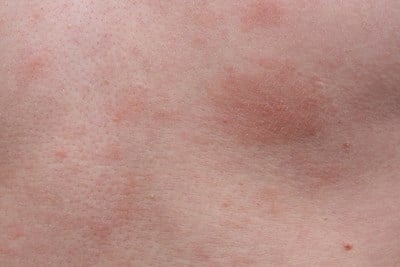Dermatitis is a group of rashes brought on by different causes. In most cases, the words “dermatitis” and “eczema” are more or less interchangeable. Although the different kinds all result in a rash, the rashes tend to have a few distinct differences. Here is a look at the symptoms of contact dermatitis, atopic dermatitis, and seborrheic dermatitis.
Contact Dermatitis
There are multiple types of contact dermatitis, just as there are multiple kinds of dermatitis. The two most common are allergic contact dermatitis and irritant contact dermatitis. Both are a result of the skin coming into “contact” with something it doesn’t agree with. The prime difference is that allergic type is because of a sensitivity and immune system response, while irritant type is the result of a substance that damages the skin’s exterior because of either the chemical makeup of the substance (like bleach) or because of prolonged contact to generally harmless substances (like excessive hand-washing).
Allergic contact dermatitis symptoms include a red rash at the area of contact. Small bumps or pus-filled blisters may form; the blisters may ooze and crust over. The rash is also likely to itch or burn and may swell. Irritant contact dermatitis results in a red rash that also tends to be only where the substance touched the skin. Again, bumps may form along with sensations of itching, burning, or stinging. The skin may develop patches of dryness that look a little bit like a burn.
Atopic Dermatitis
Atopic dermatitis is more commonly known as severe eczema and suspected to be the result of an overreaction of the immune system. Research suggests a familial link in which atopic dermatitis is more likely to present with a family history of asthma or hay fever. Generally, atopic dermatitis begins in the first six months of life and is a chronic condition. However, most people find that certain things trigger the onset of the eczema rash (dry skin, stress, and certain skin care products); it will appear and disappear periodically.
The rash itself will cause mild to extremely severe itchiness—it often gets worse from continuous scratching. This also increases the chances of developing additional infections, which those with atopic dermatitis are naturally more prone to. Small bumps may appear that can ooze and crust. The skin may crack, particularly behind the ears; leathery or scaly patches are not uncommon. The folds of the knees and elbows, along with the face, are the most common places for atopic dermatitis to occur.
Seborrheic Dermatitis
Seborrheic dermatitis occurs mostly on the scalp, although it may appear on other extremely oily areas of the body like the upper back and face (especially the nose). It’s development likely has a lot to do with an overgrowth of microscopic fungi on the skin. On the scalp, it closely resembles dandruff, with a few distinct differences. However, affected areas can also develop greasy patches with yellow, crust flakes of skin. Red discoloration is often present, along with uncomfortable itching or stinging and potential swelling. The eyelids may become red and crusty as well.


